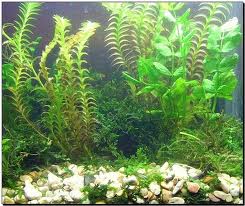





For the planting scheme of a wildlife pond to be successful and manageable, the nature of the individual species must be recognized and appropriate conditions provided to accommodate their growth habit, yet ensure containment. The most problematical plants are the rhizomatous species. A rhizome is a creeping stem, which can vary from a thin stringy growth to a chunky pointed rootstock. It will have buds at intervals along its length, and these are capable of producing fresh plants.
 Sometimes, if the water is cool and covers them comfortably, rhizomes will only branch occasionally, the main terminal growth expanding quickly. However, if grown in conditions where the water level varies, or drying out occurs, many of the buds may burst into growth in an effort to ensure the rhizome’s survival. Initially, the plants will be quite puny, but following inundation by water, they will become a forest of growth.
Sometimes, if the water is cool and covers them comfortably, rhizomes will only branch occasionally, the main terminal growth expanding quickly. However, if grown in conditions where the water level varies, or drying out occurs, many of the buds may burst into growth in an effort to ensure the rhizome’s survival. Initially, the plants will be quite puny, but following inundation by water, they will become a forest of growth.
Fortunately, many rhizomatous species are very sensitive to water depth. Therefore, they can be effectively contained and root pruned by the profile of the pool floor. A sudden drop, for example from 30cm (12in) to 90cm (36in), will be sufficient to prevent even the most ambitious reedmace from spreading. A sloping margin into the pool can create the correct conditions for a variety of species. Those that demand shallow water will only advance to a certain depth, beyond which they will not be comfortable. Others will grow better in deeper water and so on. By selective planting and careful positioning, you should be able to maintain effective control over the spread of all the plants.
Rhizomatous species tend to develop as close-knit stands in nature, so it is sensible to plant several examples together so that they form a tough blanket that chokes out other species. The stand will tend to advance outwards until it meets another species, or some form of physical barrier. As with cushion forming rock garden plants, which tend to die out in the centre if not regularly given a pinch of slow release fertilizer, the centre of a vigorous stand of rhizomatous aquatics will deteriorate, too. Applying a slow release fertilizer, of the kind given to waterlilies, will sustain lusty growth.
If your wildlife pond is arranged like a conventional garden pool, using planting baskets, some of the more vigorous rhizomatous aquatics, like the reedmace and bur-reed, will be unsuitable. They will certainly grow in such containers, but they will rapidly fill them with rootstock, distort them and possibly even burst them unless very regularly maintained. In addition, taller species like the reedmaces become very unstable if confined to a container, and will topple over in the wind unless weighted or fastened down in some way.
Fibrous-rooted marginal aquatics adapt well to container life, however, so if your pool will be planted exclusively using baskets, choose well behaved plants like the flowering rush (Butomus umbellatus) and the clump forming cotton grass (Eriophorum angustifolium). A perfectly acceptable wildlife pool can be created with non-invasive plants such as these.
Submerged aquatics, in the wildlife pool, can be grown either directly on the floor or in containers. Direct planting into soil is certainly the most natural and attractive method, but the number of species you will be able to plant together will be determined by their relative vigour. Few species can compete with Canadian pond weed (Elodea canadensis), for example, while the starworts, or callitriches, will curl up and disappear if planted with a boisterous neighbour. If you want to grow a diversity of submerged plants, basket cultivation is the answer; if a generous forest of underwater foliage is the main requirement, one or two equally vigorous species, allowed free rein, will produce a satisfactory result.
Floating plants need equally careful appraisal. Those that form mats or carpets of foliage on the water surface, like the myriad duckweeds and fairy moss, are perfectly acceptable, but they do need very careful restraining. They are ideal for controlling the development of green suspended algae, by reducing the amount of light falling into the water, but they can cut out too much light, damaging submerged oxygenating plants as well. If you are prepared to spend time on the regular maintenance of your pond, these carpeting floating plants are quite acceptable. However, if the pool is to become a part independent balanced ecological entity, they would be better omitted and replaced by less intrusive kinds, such as the frogbit and water soldier.
Waterlilies and pondlilies should be treated in much the same way as in a conventional garden pool. Despite the fact that they will grow well on an earth-bottomed pond, they will be much easier to control, cultivate and manicure if grown in a large container. A plastic laundry basket, lined with hessian and filled with soil, is ideal.
Copyright © www.100flowers.win Botanic Garden All Rights Reserved